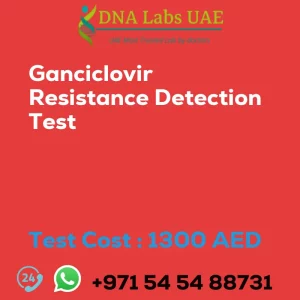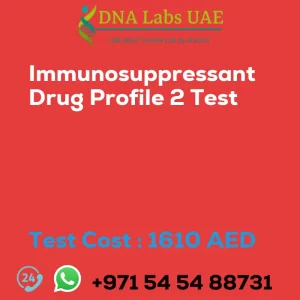5 FLUOROURACIL 5FU TOXICITY Test
Test Details:
The 5-fluorouracil (5FU) toxicity test is a laboratory test used to measure the levels of 5FU in the blood to assess its toxicity. 5FU is a chemotherapy drug commonly used to treat various types of cancer, including breast, colon, and stomach cancers. The test is usually performed before starting 5FU treatment and during the course of treatment to monitor the drug’s concentration in the blood. It helps determine if the drug is within the therapeutic range or if it is causing toxicity.
Components:
- DPYD Gene
Price:
1560.0 AED
Sample Condition:
4 mL (2 mL min.) whole blood from 1 Lavender Top (EDTA) tube. Ship refrigerated. DO NOT FREEZE. Duly filled Genomics clinical Information Requisition Form (Form 20) is mandatory.
Report Delivery:
1 week
Method:
PCR, Sequencing
Test Type:
Pharmacogenomics
Doctor:
Oncologist
Test Department:
MOLECULAR DIAGNOSTICS
Pre Test Information:
Duly filled Genomics clinical Information Requisition Form (Form 20) is mandatory.
Test Procedure:
The test involves drawing a blood sample from the patient, usually through a vein in the arm. The blood sample is then sent to a laboratory for analysis. The laboratory technicians use specialized equipment to measure the concentration of 5FU in the blood. The results of the test are usually reported in micrograms per milliliter (g/mL) or nanograms per milliliter (ng/mL).
Test Results and Interpretation:
The therapeutic range for 5FU varies depending on the specific cancer being treated and the individual patient’s characteristics. Healthcare providers compare the test results with the therapeutic range to determine if the drug dosage needs to be adjusted. Toxic levels of 5FU can lead to severe side effects, such as bone marrow suppression, gastrointestinal problems, and damage to the liver. By monitoring the drug levels, healthcare providers can adjust the dosage or make necessary interventions to prevent or manage toxicity.
Importance of Regular Monitoring:
It is important for patients undergoing 5FU treatment to follow their healthcare provider’s instructions regarding the timing and frequency of the test. Regular monitoring of 5FU levels can help ensure the drug is effective in treating cancer while minimizing the risk of toxicity.
| Test Name | 5 FLUOROURACIL 5FU TOXICITY Test |
|---|---|
| Components | *DPYD Gene |
| Price | 1560.0 AED |
| Sample Condition | 4 mL (2 mL min.) whole blood from 1 Lavender Top (EDTA) tube. Ship refrigerated. DO NOT FREEZE. Duly filled Genomics clinical Information Requisition Form (Form 20) is mandatory. |
| Report Delivery | 1 week |
| Method | PCR, Sequencing |
| Test type | Pharmacogenomics |
| Doctor | Oncologist |
| Test Department: | MOLECULAR DIAGNOSTICS |
| Pre Test Information | Duly filled Genomics clinical Information Requisition Form (Form 20) is mandatory. |
| Test Details |
The 5-fluorouracil (5FU) toxicity test is a laboratory test used to measure the levels of 5FU in the blood to assess its toxicity. 5FU is a chemotherapy drug commonly used to treat various types of cancer, including breast, colon, and stomach cancers. The test is usually performed before starting 5FU treatment and during the course of treatment to monitor the drug’s concentration in the blood. It helps determine if the drug is within the therapeutic range or if it is causing toxicity. Toxic levels of 5FU can lead to severe side effects, such as bone marrow suppression, gastrointestinal problems, and damage to the liver. By monitoring the drug levels, healthcare providers can adjust the dosage or make necessary interventions to prevent or manage toxicity. The test involves drawing a blood sample from the patient, usually through a vein in the arm. The blood sample is then sent to a laboratory for analysis. The laboratory technicians use specialized equipment to measure the concentration of 5FU in the blood. The results of the test are usually reported in micrograms per milliliter (g/mL) or nanograms per milliliter (ng/mL). The therapeutic range for 5FU varies depending on the specific cancer being treated and the individual patient’s characteristics. Healthcare providers compare the test results with the therapeutic range to determine if the drug dosage needs to be adjusted. It is important for patients undergoing 5FU treatment to follow their healthcare provider’s instructions regarding the timing and frequency of the test. Regular monitoring of 5FU levels can help ensure the drug is effective in treating cancer while minimizing the risk of toxicity. |








